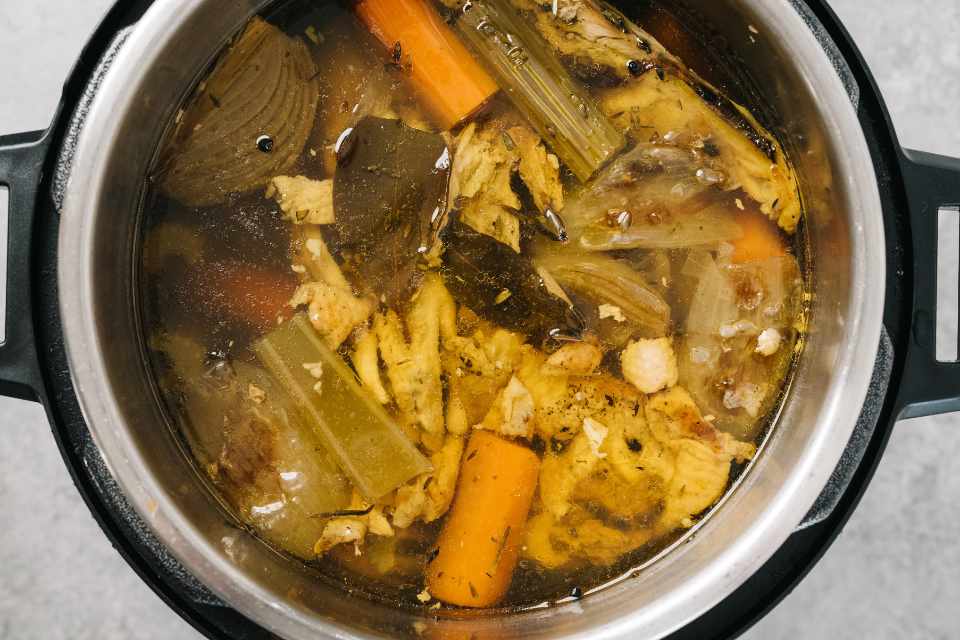Traditional slow-cooked meals made with meat on the bone have a reputation for providing health benefits. I’m thinking specifically of chicken soup here. What my mother used to call Jewish penicillin. Full of flavour, wholesome and packed with nutrients. Nowadays, bone broth is generally held in the same esteem. Providing healing nutrients in a form that is easy to assimilate. Yet some people question the safety of consuming this nutritious broth on a regular basis. Let me explain why so that you can make up your own mind.
Bone broth benefits
Animal bones contain proteins, minerals such as calcium and magnesium, and other nutrients. If we simmer these bones we might expect that these nutrients would transfer into the cooking liquid. So, broth is made by simmering bones (usually chicken, lamb, beef or fish) in water. A slow cooker or stock pot can be useful, especially if making a big batch of homemade bone broth.
The recommendations often suggest starting from cold water, adding meaty bones, and raising the temperature to a simmer. Continue to simmer in water for several hours, or even up to a day or more. Some people also add vegetables, herbs, seasonings or vinegar, making a bone broth soup. Longer simmering helps to break down connective tissue and release the nutrients. For instance, chicken bones simmered for twenty-four hours will crumble between your finger and thumb.
So, if you are looking for a natural source of minerals such as calcium, broth might seem a good option.
Similarly, you won’t find a better source of amino acids such as glutamine. Supplements of glutamine are sometimes recommended to support the health of the intestinal barrier. So, if you are trying to heal a leaky intestinal lining, then you may have heard about the benefits of broth.
The best bones for bone broth
The types of bones you use will affect the nutrient content of your broth. It takes far longer to extract nutrients from bigger bones such as beef than it does from poultry bones. Also, the long bones, such as thigh have a different composition than the flat bones such as ribs or shoulder blades. The long bones are composed of what is called compact bone and have a higher content of minerals than flat bones.
As well as minerals, bones are a good source of several amino acids and broth mainly contains the non-essential amino acids, proline, glycine, glutamine and alanine. Non-essential means they are not an essential part of the diet as the body can make them. These amino acids can help to strengthen or build the proteins in your body.
For instance, if you add broth to your diet, the first thing you might notice is better skin health, or healthier hair and nails. Consuming broth helps to plump up the skin, provide elasticity and reduce wrinkles. It also helps to heal injuries, wounds, burns and ulcers. In addition, it prevents muscle wasting and heals a damaged gut mucosal lining. This latter point suggests broth could improve your digestive health.
In addition, it is beneficial to make your broth from bones that contain joints. The cartilage, tendons and other connective tissue in joints provide a rich source of nutrients such as glucosamine. These nutrients may help to build and repair the joints in your body, improving your joint health.
Are there any health risks with bone broth?
Some people suggest that drinking broth on a regular basis may present a potential health risk.
Three potential reasons there may be problems with consuming bone broth:
- bones may contain heavy metals
- some people may be sensitive to glutamate levels in broth
- some people may be sensitive to histamine in bone broth
Bone broth and toxic metals
As well as the beneficial minerals such calcium, magnesium and zinc, it’s possible that bone contains heavy metals. For instance, the bones may contain toxic metals such as cadmium or lead. And, just as we extract the calcium or magnesium we could also extract toxic heavy metals.
However, this study found that not only was the concentration of calcium and magnesium low in broth. But, heavy metals were either not found, or the concentration was so small as not to be a concern. Researchers found that both homemade broth and commercial brands contained low amounts of calcium and other minerals. In fact, for each serving of broth, they estimated that calcium levels were less than 5% of the daily requirement. Though they did find that adding an acidic ingredient such as vinegar could increase the calcium levels of a batch of bone broth. This suggests that adding vinegar during cooking might also increase other metals in broth too.
Glutamates, Broth and the GAPS diet
Gut and Psychology Syndrome (GAPS) diet is a special diet for children with autism. It starts with an introduction phase. In this initial part of the GAPS diet, it is better to have meat stock rather than broth made from bones. Meat stock contains the same healing amino acids as broth from bones. But, the concentration of glutamate in meat stock is much lower. In fact, meat stock contains around a third of the amino acids of broth.
Meat stock preparation involves simmering meaty bones. But cooking times are shorter. For instance, cooking time for meat stock is less than two hours. While for bone broth stock the cooking time is usually between 1 to 3 days.
On the GAPS diet, there is a slow transition from using meat stock to using broth made with bones. As the gut heals, people can better tolerate broth.
The synthetic product monosodium glutamate (MSG) can cause problems in the body. This is because it is stimulating to the brain. Glutamine in broth can convert into glutamate. And some people think there may be a link between glutamate and migraine headaches, ADHD or autism.
Unfortunately, MSG or similar food additives, such as yeast extract, are found in most processed or packaged foods. These man-made additives are concentrated sources of glutamates. And they can cause side effects in some people.
For this reason, I would recommend that everyone should avoid processed foods wherever possible. This is especially true if you suffer from migraine headaches, neurological or digestive problems.
Similarly, bone broth may also cause problems for some people. One theory is that this occurs when the brain has an excess of free glutamates from eating a poor diet. Adding even a small amount of glutamate adds to the excess of glutamate in the brain creating overstimulation. If you find consuming broth causes headaches or other symptoms then it makes sense to limit how much you eat.
Bone broth and histamine intolerance
Another possible issue with broth is histamine intolerance. Bones contain the amino acid histidine and long, slow cooking can transform histidine into histamine. So, bone broth can contain histamine. What’s more, the histidine can continue to form histamine with storage. When your batch of broth is finished and cooled, freeze it quickly to minimise the production of histamine.
If you are freezing broth in glass jars, make sure you only use freezer-safe jars and don’t overfill them.
For most people, histamine in foods does not cause a problem. But it is true that some people are very sensitive to the amount of histamine they consume. If you develop an itchy skin rash, hives, stomach upset, migraine headache or a runny nose it could be due to histamine.
While it is possible that bone broth may cause problems for some people, this is not true for everyone. In fact, it is likely that most people will thrive on it. For instance, it seems that the theoretical risk of heavy metal content is unlikely to be an issue. On the other hand, if you develop symptoms of histamine sensitivity, or have a known glutamate sensitivity, then you may need to limit or avoid regular consumption. If you experience any side effects whilst consuming bone broth then it is a good idea to contact your healthcare provider.








0 Comments